| | | | | | |
|
Transcript of Ben Read's lecture at the Royal Society of British Sculptors, 15th October 1998. |
| | | | | | |
|
I have to admit that I'm slightly disconcerted by the large numbers but of course I shouldn't be. I think in honour of Arthur Fleischmann it is very appropriate that so many people should come together and I know it's not for me to say, but it's due to the indefatigable efforts of Joy.
|
|
Earlier this summer a plaque was installed and unveiled outside Arthur Fleischmann's home and studio.
This honoured a sculptor who for over forty years had pursued a major career in this country. This is a shot inside his studio. He executed public works portraits of the great and good and ordinary people as well. He worked in a range of media.
|

|
|
Fleischmann in his studio
|
|
|
Some in a pioneering capacity, and I should add here that he was a Fellow of the Royal Society of British Sculptors since the late 1950's till his death in 1990.
|
|
But there is first of all one problem involving Arthur Fleischmann and that is that if you look
at the history books he's not there. As I will mention later it may be a problem with the history
books rather than Arthur Fleischmann's career as a sculptor. There is actually another problem in
terms of Arthur Fleischmann he was over fifty when he arrived in England. He had pursued his career in
four continents let alone four countries and he spent his formative years in central Europe.
We have difficulties today in appreciating the changing political boundaries and notions of
nationality. He was born in 1896 in Bratislava, it was then called Pressburg but is now
capital of Slovakia. It had been the site for the coronation of the kings of Hungary and was a
major city of the Austro-Hungarian empire but a lot has changed since that time.
|
|
Leaving aside these political complexities which I don't want to go into in present company the
major problem is actually not with politics but with an artist who grew up, trained and practised
in central Europe, a culture which few in this country have the remotest knowledge of.
|
|
|
Possibly the only sculptor from almost east of the Rhine in the 20th century that we have some
idea about is Hans Barlach the German expressionist sculptor. There are three museums dedicated
to his work in various parts of Germany. In fact the whole world of sculpture in Europe, in what
I would call in old-fashioned terms "Central Europe" is scarcely known at all in this country. Arthur
Fleischmann first trained in the Prague academy in 1920 under Jan Sturza and very few in this country
have heard of him or could describe his work to you.
|
|
In 1922 Arthur went to Vienna where he trained,
and Vienna was the setting for an immense environment for sculpture both before and after the First
World War. The sculpture in Vienna in the late 19th and early 20th century was not just the last flourish of
the Hapsberg empire, but to a certain extent even still, the cultural centre for central and eastern
Europe. What I show you here is a late 19th century sculpture the one which Prince Eugens in Vienna in
the Oden Plaz in front of the Hoffberg. This is all part of the late 19th early 20th cent proclamation
or the last dying gasp of the Hapsberg empire. But there was a lot of sculpture going on in this context.
|
|
Here we have the Ringstrasse with the parliament building of 1873-83 with, behind it, the gothic town hall.
In front of it is this extraordinary classical revival sculpture by Kundman of 1902.
That's just late 19th or early 20th century. We then get sculptors such as Hanak whose dates are 1875 to 1934
whose works fortunately survive in the Hanak Museum on the outskirts of Vienna. This is, so to speak,
an example of a sculptor practising in the early and first third of the 20th century. The photograph is two
slides of Hanak works in the garden of the museum it is a formalised figurative art but it is not Rodin's
realism or strict neo-classical. It is an example of a sculptor developing, trying to find a new value in
the figurative tradition, which, of course, is central to Western European sculpture.
|
|
This is another in the public gardens in Vienna "The Strength and Beauty of Our Youth" by
Josef Mulner who is of particular relevance because he was Arthur Fleischmann's professor at
the Vienna Academy. This is who Arthur studied under. This is more of an idealised and classical
and figurative style. But this is in the first third of the 20th Century. This is a no-go area for art historians because it is this style that was taken up by the national socialists in Germany for their art and this has, so to speak, condemned what was a valid respectable style of sculpture in the first 30 years of this Century.
|
|
People don't like to look at it or think about it with one or two exceptions. It was in the context of Vienna that Fleischmann came to Vienna to study after studying in Prague and where his first works can be found. This is an archive photo of an altar-piece of the 12 apostles in the church of St Elizabeth in Hagen in NW Germany. It is interesting, I would say, that of Fleischmann's works of the 1930's when he first came to prominence as an accessible sculptor that they are actually scattered across Central Europe. I do believe that there was a cultural context across Central Europe irrespective of national boundaries that may have gone up after the 1914-18 war.
|
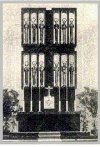
|
|
Hagen
|
|
The church at Hagen was designed by one of the Bern brothers. These were expressionist architects. Again we know nothing about expressionism in this country - certainly very little - certainly not about expressionist architecture. In Germany, Austria and elsewhere, one of the most exciting and formally extravagant almost style of building in the inter-war period.
|
|
The other thing about this is that it is a Church commission. I will get onto this again later. The statues are made in ceramics. Now there survive in Brat in Fleischmann's home town a number of similar ceramic figures of saints - this is St Andrew, this is St James of about 1930. These are photos taken by Dominique in 1990, when the rediscovery of Arthur Fleischmann in his own country first began. Certainly by the time of the exhibition in 1996 a large number of these early works, I would like to say "mysteriously", but they did emerge from museums stores and so on. One likes to think that the home country was beginning to rehabilitate one of their great artists of the 20th Century. It is ceramic, it is coloured and I don't have slides of Central Europe. The English are not interested in such things, but other Czech sculptors, central European sculptors such as Muntfreund who is famous as a cubist sculptor with others such as Stefan and Dvorzak who were working in the objective realism movement. It's not the same style but they were using coloured ceramics as part of the area of their activity.
|
|
This is one of the blocks of flats set up in Vienna by the Social Democratic local government in the 20s and 30s. It is one of the most amazing instances of socially justified creative architecture with sculptural decoration. It set up a large number of large blocks of flats to re-house the workers in 20s and 30s.
|
|
This is a block at Hickelgasses in Vienna put up in 31 with a Frieze on it by Arthur Fleischmann.
The inscription "Peoples dwelling house erected by the community of Vienna in 1931" and below it a series of reliefs by Arthur Fleischmann in ceramics.
This is a detail.
|
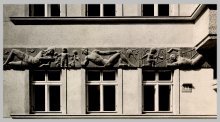
|
|
Hickelgasse
|
|
|
This is another work in ceramic by Fleischmann in Vienna in Wagramastrasse in 1933. This was the war memorial to the 700000 Austro-Hungarian prisoners of war imprisoned in the First World War. This is a detail, but notice the tradition in the Christian topic. In fact so Expert at ceramic was Fleischmann that he teach ceramics at the Women's Art Academy in the mid 1930s. It was very interesting when we were first trying to retrieve Fleischmann, that an eminent professor of art history in Vienna denied that there had actually been a women's academy of art in Vienna but luckily I managed to find a book in German on women artists in Germany and Austria that gave 5 pages about the academy.
|
|
I don't want to go on about this too much but this is the type of historical problem that we have with many artists of the 20th Century.
|
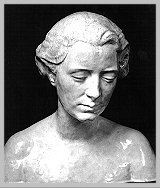
|
|
Jansen Ceramic
|
|
This is a bust of Julia Jansen of 1932 in coloured ceramics in Bratislava and this is another bust of Julia Jansen about 1935 in wax. You can see that Fleischmann is using different materials. He is not just experimenting - he is deliberately using a wide range of materials, both conventional and less conventional which I think is a reflection of the continued ideology of the great C E arts and crafts movement that started in 1890s but was still effective in the 1930s.
|
|
The standard situation I try and teach my art historical students. The famous phrase from Shakespear's Macbeth. Macbeth says to his wife "The king's coming tonight" and she says "when is he going?" and this is crucial. History is studied by when things start, never by when the finish. What ever that means.
|
|
Now this is a wooden carving "Motherhood" of 1937. Notice it is carved wood by Arthur and is still in the studio. Our notion of, in inverted commas "Truth to Materials" direct carving. These are not just British concerns relating to Henry Moore and Barbara Hepworth. There is again a whole history of truth to materials that extends over Europe and quite possibly America. Here again I show you, because I have a slide of it, a Balach wooden carving, but it is all idealisation found in German and Czech and Slovak sculptors of this period.
|
|
The motherhood figure was executed by Fleischmann before he left Vienna and to go to South Africa in 1937. He actually went there as doctor for a Viennese Ice-hockey team. What I left out was that before he became a sculptor, he trained as a doctor as well.
|
|
When he got to South Africa - he was there for two years - he had a major exhibition in Johannesberg of forty works including the motherhood figure, and then the following year - 1938 - he visited Pretoria.
|
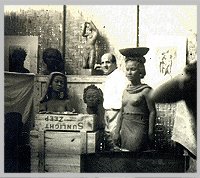
|
|
Fleischmann in his studio - Bali
|
|
Then in 1939 he moved on to Bali in the Dutch East Indies. He wasn't there for long, but it was clearly a revelation to him and he wrote about it and I think an attempt is being made to publish his account of his time in Bali. This is a single work arising from this - the "Balinese Legong Dancer" 1939-40. Cast in Bronze only in 1960, but I think what so captivated him was not just a different culture, but a completely different civilisation.
|
|
I think in particular, the - one might almost describe it as a stylised movement of the dancers and those of you from the RBS will probably realise, the capturing of movement in the static form of sculpture is one of the great conundrums of the art.
Clearly Fleischmann was grabbed by it and in later figures as we will see there developed this capacity for movement in sculpture.
|
|
The same year he moved to Australia where he spent 9 years and built up a career as a prominent sculptor. This is an archive photograph of his studio in Merioola in the 1940's and it was actually he's there. There was a Merioola Group. He very quickly associated with a very prominent - if you like Avantgarde - painters, sculptors and so on in Australia. He had an extremely successful career there.
|
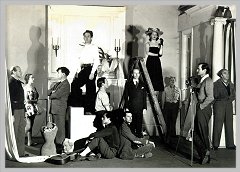
|
|
Fleischmann with the Merioola Group
|
|
|
He did public commissions - a series of fountains including the wishing tree memorial of 1946 in the Botanical Gardens in Sydney - here's a general view and a close-up. He executed bronze doors to the state library of NSWE in Sydney. He did church work which I'll get on to later and portrait busts of the eminent in Australia.
|
|
There is one work which seems to me to coverise the time in Australia, the statue of Cyrano de Begerac, the great literary figure of 1944. If you remember what I was saying about movement - he's got it - it's amazing how it almost energises in front of your eyes. He rather liked it - here he is in front of it. But his position in Australia was such that one critic claimed that he had been a strong influence in the work of contemporary Sydney sculptors doing much to elevate the depressed status of sculpture in New South Wales.
|
|
But in spite of that, in 1948 he arrived in England and that is where he established the career of the last 40 years of his life. Soon after he arrived, he executed this portrait bust of Trevor Howard the actor as Petruccio in 1949.
|
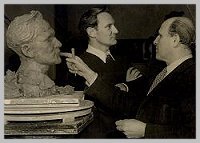
|
|
Trevor Howard
|
|
|
This very intriguing intricate terracotta work of Suzanna and the Elders of certainly executed by 1950. This is a portrait bust. This I deliberately took from a distance because here's his mallet and things like that still there to this day on the sculptor's stand.
|
|
"First Step" of 1950 is again one of these carved wooden pieces, "The Four Temperaments" - there is a rather intriguing series of groups of figures which started in Australia with "Bondi Beach", but this is the ….. A more Ideal topic.
|
|
Here again is a Ballach - I'm not saying that there is a Ballach influence. All I'm saying is that there is a European convention of small groups of animated figures and I only show this because it is the only slide I've got. Here we have Arthur in his studio in Green Street in 1950's hard at work. That's Cyrano in the background not to be missed. But in the foreground is the figure of Miranda. This was an early public commission being received from the Lockheed Company to form part of the Festival of Britain gardens and the whole area surrounding the festival hall are still there - there was also the dome of discovery, the Skylon. It was the great public occasion of the 1950's - and Fleischmann was there with this figure of Miranda and a fountain figure of a mermaid. There is a wonderful account in at least 2 news papers of Fleischmann saying "Mermaids with fish tails are rather dull. Why shouldn't a beautiful mermaid have legs - she can still swim with the fins on her feet. Although that's only how I imagine a mermaid - I've never actually met one."
|

|
|
Resurrection
|
|
I bring up the topic of public commissions, because these, I think, are a measure of a sculptor's success. For instance in 1958 he executed a large series combination work for the Vatican Pavillion of the Brussells International Exhibition of that year of the Ressurection. This is a shot of the figure of Christ actually being installed. I show it because you get some idea of the scale. This is a general view. It was the figure of Christ above and a frieze below and here are your … work - it was a huge work.
|
|
This I think is a detail of the figure of Christ in Aluminium - again a non-traditional material. This is a figure of St Benedict is actually a model in wax for a Lifesize bronze at Ealing Abbey in London of 1963.
|
|
I think I should emphasise here that in his time in England Fleischmann executed between 1957 and 1985 at least 22 church projects decorating the interiors of churches. Some quite substantial.
|
|
This is something I have sort of tried to badger people about before. There is a whole alternative culture of church art following the second world war. Churches were being repaired. New work was being installed in them. There was an expansion of church buildings with works of art in them. At St Aiden's Acton here in London there is this amazing collection of works by Arthur Fleischmann by Roy de Maistre, by Graham Sutherland and a polish ceramicist Kotofski, whom I just happened to get invloved with. There is an alternative world there of the commissioning of art for specific purposes that, with no disrespect to esstablished art historians, simply doesn't feature in our notion of cultural history in the post-war period.
|
|
This is the model for a fountain commissioned by the national coal board for Melton near Manchester of 1954. So it wasn't just church work that he was doing. Here it is in the Studio.
|
|
Here you have a studio interior with a variety of his works. He executed portrait busts. He certainly executed busts of 4 popes and Cardinal Bea - that bore even than Bernnini or Cannova. As Philip very kindly pointed out. A pretty good record.
|

|
|
Mary Ellen
|
|
Some are more popular figures. Here is Dame Edna Everage. Mary-Ellen of 1979. Note the use of mosaic incorporated into it and this portrait bust of Joy in 1957.
|
|
This is more elaborate work "Spring" originally of 1949 in terracotta for a fountain. It was only cast in bronze in 1990. Among the fascinating archives of photographs which, those of you who are not sculptors may find interesting, this is the mould that it's cast from. This is a complete negative impression. I won't go into the technical details of how a cast is made - I'm sure there are several people here who could explain it much better than me.
|
|
This is a Madonna and child here of 1964. Apart from this, from about 1949, Fleischmann is working in a more experimental way in Perspex.
|
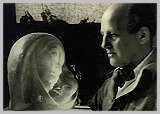
|
|
Phenolic Madonna
|
| |
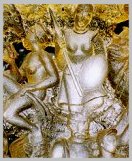
|
|
Detail from 'Jupiter'
|
|
This is the adventures of Jupiter of 1952. One of the earliest Perspex carvings. Now Perspex is a very tough material, it's not easy, it's not like alibaster which is as soft as butter or marble if you can get it at the right stage you can just chip away at. It is a very elaborate one. What I think Fleischmann found so fascinating about it was that it plays with light in a crucial way that marble and stone these are solid…. But if you get lighting behind it you get a completely different effect.
|
|
He tried it in quite major works. This is Lot's Wife of 1957. This was actually shown at the London County Council Exhibition "British Sculpture 1850-1950" held in Holland Park in 1957 which is one of these major series of exhibitions sponsored by the LCC for which somebody much more expert than I is present here so I won't go into it.
|
|
If you can follow that, it was actually exhibited in the British Pavilion in Brussels in 1958 - the same international exhibition that the Resurrection series of works had featured in.
|
|
Again, four popes, two pavilions in 1958. You can't do much better than that in professional terms. Again if you get into the right angle, it is the impression of the light going through it, but also being broken that is important. International exhibitions in Seattle 1962, Osaka 1970 and the World Expo in 1988 in Brisbane.
|
|
This is the "Merchildren and Corals" of 1966. It is the first of a series of major commissions he received for the fitting out of Ocean Liners between 1955-1968 which very often had maritime titles. It is very much a part of that pattern of work of what he executed. He also executed abstract works in this material. "Flight" abstract of 1963. From this developed the amazing fountains of the 1970's through to the 19990s. This is "Aztec Jewel", "Four Seasons". What is so crucial about these is, it is not just the light affecting the coloured Perspex, they should have water going up and just trickling down. He is creating, if you like, a change of mood. The light is different all the time and I feel, I have no justification for saying this, but that towards the end of his life he really felt that he had cracked this problem of movement in sculpture. The play of water with the Perspex and with the light, makes them almost, I would say, electric in their effect.
|
|
This is the last of these Perspex works "Homage to the Discovery of DNA", started in 1986 and only finished in 1990. There are at least 2 versions. The first actually appeared on the set of the "Empire Strikes Back" - I mean how modern can you be. Space Age Fiction - here it is. It seems to me highly suitable. The second version was installed postumously in 1990 in the State Library in Sydney, NSW. Again the topic - it is homage to a crucial scientific discovery of our age - of our recent age - not Einstein or Splitting of the atom or something like that but something right up to date.
|
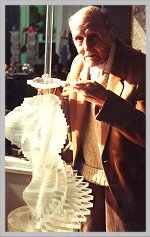
|
|
DNA
|
| |
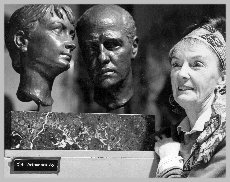
|
|
Joy with double portrait
|
|
I will conclude with some random thoughts but also with much more important I find one of the finest of his portraits. This is a portrait of Cecile Joy and Arthur Fleischmann of 1957 which still presides over the studio. The studio is largely complete there and by request is accessible I think. It is an experience to go there and see the artists life work in its original setting, that is terribly important.
|
|
I hope I've shown that Fleischmann had a very distinguished career, both in the first part of his life and I think later in this country. But I do want to revert finally to the problem I identified at the start - i.e. that he's not in the history books. The years of his English career whitnessed the triumph of Henry Moore, Barbara Hepworth, the 1950's saw the rise of the so called Geometry of of Fears school of scupltors and the English constructuivists, though what later in inverted comments history doesn't relate. Historians have a habit of dumping people what they're no longer fashioanable. In the 1960's came Karo and the St Maretin's School, 1980's the sort of new British sculpture. There has been evidently in British sculpture a continuous development and excitement every day. But this is all of course official history.
|
|
What I hope I have demonstrated is that we can't entirely trust official histories. We must always remain alert and above alll curious to find out what else was going on. We must be ready to admit that in a wider context of history that there have been significant sculptors active who have not been traced in the official history - there have never the less been significant figures who have been unjustly ignored.
|
|
Thank you very much.
|
|
|













